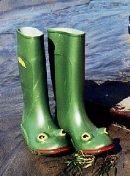One of the claims made in the article - which I think was actually a simple repetition of one of Philippe Aries's claims - was that prior to the late 18th/19th centuries, most people had a very pragmatic, detached view toward child deaths. It also suggested that even in New England, during the colonial Puritan years, families wouldn't name their new children until the child had lived to a certain age. The students were assigned a writing exercise on this essay, so I read, over and over (times almost 50, the number of students I was responsible for), about the way that people in the Olden Days were relatively unmoved by the deaths of their children. One of the quotes that got used in all these student papers came from (I think) Aries - that people in the early modern era would simply throw the corpses of their dead children out like so much trash, or bury them in yards in the way we now bury our pets.
I always felt like this could not be true across the board. I wouldn't argue with the suggestion that occasionally, some (probably very poor) people disposed of their young dead this way. Just about everything imaginable has happened in the course of history. But to square that image of dead-disposal with the fact that, until VERY recently, Europe and North America were mostly exceedingly serious Christians - it's ludicrous. No Christian would throw away the body of a dead child; they would inter them in consecrated ground. And even way back in the medieval period, Christians took burial seriously. But I could never find real confirmation for my suspicions about dead children.
Two weeks ago, I was in Boston for a conference. I had a fair bit of free time, and decided to tourist myself around the city; I hadn't been to Boston since I was about five or six. I did the Freedom Trail, since it's free and easy, and while I felt very uneasy about the "Freedom" and "liberty" propaganda [I had just re-read Octavian Nothing], I mostly quite enjoyed it.
Especially the cemeteries.
I ended up in two very old, pre-Revolutionary cemeteries: Copps Hill and Granary Burial Ground. Copps Hill, located just a few blocks from Old North Church (of one if by land, two if by sea fame), was really mesmerizing. Both cemeteries were, really, but Granary holds the graves of Hancock, Samuel Adams, Paul Revere and was more touristy.
I spent a very long time inspecting the gravestones, and taking photos of them. They were macabre and worn, but beautiful in their way. And utterly fascinating. The amount of text on the gravestones was surprising to me; one quoted Milton, which I found unexpectedly moving. Paradise Lost is quoted and revered today, now, in 2009; the grave on which a line from the epic is quoted was established 260 years ago or more (only about 100 years after Paradise Lost was written!)
But I found the stones of a number of children, some of whom had their ages inscribed on the gravestone, along with their dates. The saddest of these, and the one that proved my earlier instinct that people were not just tossing out their unnamed dead babies with the trash, was for an infant born and buried in 1696.
Transcription of the epitaph:
Joseph the son/ of Joseph & /Hannah Dol/Beare. Born/ & Died Janua/ry 31, 1696.
Born and died on the same day, small Joseph Dolbeare, son of Joseph and Hannah, buried under a small stone in the Granary Burial Ground in 1696, near the then-heart of Boston. In the same small cemetery where John Hancock and Paul Revere, Samuel Adams and Peter Faneuil, and other leaders of the Revolution, would be interred.
Not exactly tossed out, uncared for, unloved, unnamed, like so much garbage.









